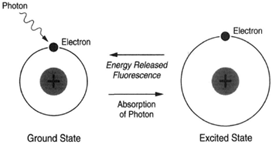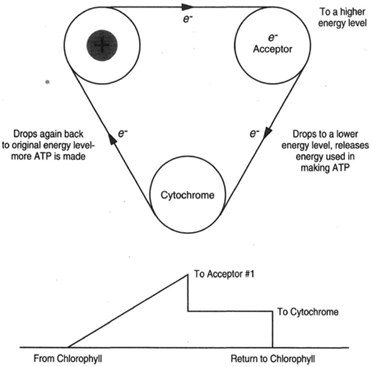Electron Transfer
 |
| Figure 9-9 Energy from light can cause an electron of a chlorophyll molecule to dislodge from its orbit and move toa higher orbit. The electron may then immediately fall back to its original orbit, thereby releasing energy and, ins o doing, causing an emission of light (fluorescence). |
What is the role of light in photosynthesis? When a unit of light, a photon, strikes and is absorbed by a molecule, an electron in the molecule dislodges from its orbit and moves to an orbit farther out from the atomic nucleus. That is, it moves to a higher energy level. Because this condition is unstable, the electron may promptly fall back to its original orbit (figure 9-9). In doing so, the energy that was invested is released. Although some of the energy will be lost in the form of heat, the remainder may take the form of light, causing fluorescence. Chlorophyll, then, acts as both a receiver and a source of light. Because some energy is lost as heat, less energy is available for light production than was invested in the molecule. The color of the light in fluorescence is therefore shifted toward the red. Fluorescence in a solution of chlorophyll can readily be demonstrated in the laboratory.
 |
| Figure 9-10 At top, cyclic electron transfer wherein an electron moves from a chlorophyll molecule to an electron acceptor (at a higher energy level) and then drops in down energy in two steps (first to a cytochrome and then back to the chlorophyll molecule). The energy released at each step is used in the manufacture of ATP. At bottom, the same events. Light shining on a molecule of chlorophyll transfers an electron from the chlorophyll molecule to another molecule (electron accept 1) at a higher energy level. The electron then falls back to its original place in the chlorophyll molecule, the transfer process being accomplished in two steps. Absorbed energy is released at each step, and the released energy is used in the manufacture of two molecules of ATP. |
Of course, if energy is dissipated as heat or light, no manufacture occurs. In order for the energy that is trapped when light shines on chlorophyll to become available for carbohydrate manufacture, it must be harvested in certain energy-rich molecules. Two such molecules are nicotine amide dinucleotide phosphate (NADPH) and adenosine triphosphate (ATP).
In the normal events of photosynthesis, when light energy is absorbed by the chlorophyll and an electron is dislodged, it is passed on to another molecule rather than returning immediately to its original place. The molecule that captures the electron is called an electron acceptor; the molecule that provides the electron is called an electron donor. The electron acceptor molecule quickly passes the electron on to another acceptor molecule, and this process may continue through several intermediaries.
An electron dislodged from chlorophyll takes one of two pathways as it moves from station to station. One pathway has the dislodged electron first traveling to several intermediate molecules and then returning to the chlorophyll. This is called cyclic electron transfer. In the other pathway the dislodged electron does not return to the chlorophyll. The then positively charged chlorophyll is again neutralized (that is, regains an electron), however, by an electron derived from water. This is called noncyclic electron transfer.
Consider first the cyclic electron transfer pathway Because light invests energy in the chlorophyll, an electron in the chlorophyll is excited and moves to another molecule (an electron acceptor) in a higher energy state. As it is passed from molecule to molecule, the electron loses some of its energy until, by the time it returns to the chlorophyll, all the energy with which it was invested has dissipated. The chlorophyll thus returns to its normal state.
As energy is released from intermediate molecules, it is harvested to make ATP Adenosine diphosphate (ADP) present in the cell is linked to a third phosphate group (also present in the cell), thus making ATP. Energy is stored in the bond that links the third phosphate group. The energy-rich ATP molecule can then provide energy needed by the cell for its metabolic activities. The process is called photophosphorylation. The discovery of ATP manufacture in chloroplasts was a significant finding because it had previously been supposed that ATP was made only in mitochondria. This finding is credited to Daniel Amon, who did his work at the University of California at Berkeley in 1954.
Noncyclic electron transfer produces other energy-rich moleculesT. his pathway is more complicated than is cyclic transfer and is, therefore, presumed to have evolved later than the more primitive cyclic method. As in the cyclic pathway, an electron moves from the chlorophyll molecule tot her intermediate molecules and energy is harvested in certain molecules. Nicotineamide adenine dinucleotide phosphate (NADP) acts as an electron acceptor, becomes negatively charged (is reduced), and, thus, can receive a positive charge in the form of a proton. The proton (which is also a hydrogen nucleus) that attaches to NADP comes from the breakdown of water. The NADP thus becomes NADPH, an energy-rich molecule. Water is split into electrons, protons, and oxygen. Two molecules of water must be lysed in order to produce one molecule of oxygen (figure 9-11).
| Figure 9-11 Two molecules of water must be broken down to liberate one molecule of oxygen. |
Because ATP is also produced, noncyclic electron transfer yields two kinds of energy-rich molecules. Oxygen is liberated to the atmosphere, and electrons flow to the electron-deficient chlorophyll. These electron transfers, the formation of ATP and NADPH, the lysis of water, and the release of oxygen are facets of the light reactions of photosynthesis




